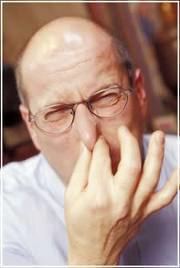 | ||
The odor detection threshold is the lowest concentration of a certain odor compound that is perceivable by the human sense of smell. The threshold of a chemical compound is determined in part by its shape, polarity, partial charges, and molecular mass. The olfactory mechanisms responsible for a compound's different detection threshold is not well understood. As such, odor thresholds cannot be accurately predicted. Rather, they must be measured through extensive tests using human subjects in laboratory settings.
Contents
Optical isomers can have different detection thresholds because their conformations may cause them to be less perceivable for the human nose. It is only in recent years that such compounds were separated on gas chromatographs.
Values
Odor detection value
Odor threshold value (OTV) (also aroma threshold value (ATV), Flavor threshold) is defined as the most minimal concentration of a substance that can be detected by a human nose. Some substances can be detected when their concentration is only few milligrams per 1000 tonnes, which is less than a drop in an Olympic swimming pool. Odor threshold value can be expressed as a concentration in water or concentration in air.
Two major types of flavor thresholds can be distinguished: the absolute and the difference threshold. The odor detection threshold and the odor recognition threshold are absolute thresholds; the first is the minimum concentration at which an odor can be detected without any requirements to identify or recognize the stimulus, while the second is the minimum concentration at which a stimulus can be identified or recognized.
The odor threshold value of an odorant is influenced by the medium.
Examples of substances with strong odors:
Variables
Threshold in a food is dependent upon:
The concentration of an odor above a food is dependent on its solubility in that food and its vapor pressure and concentration in that food.
